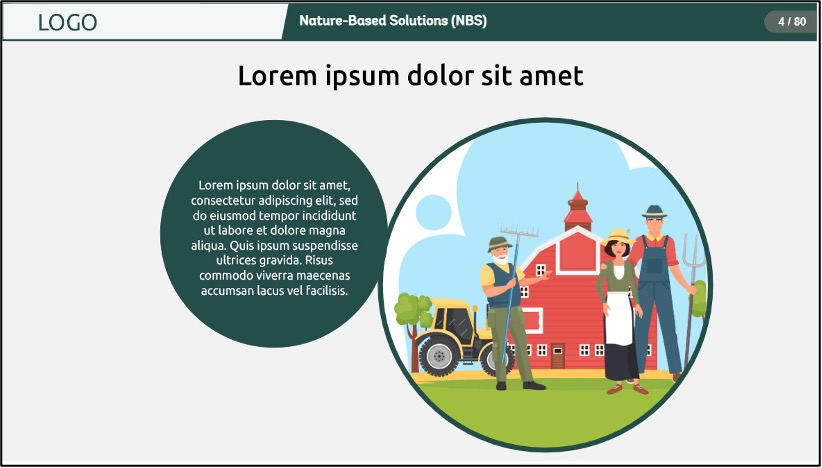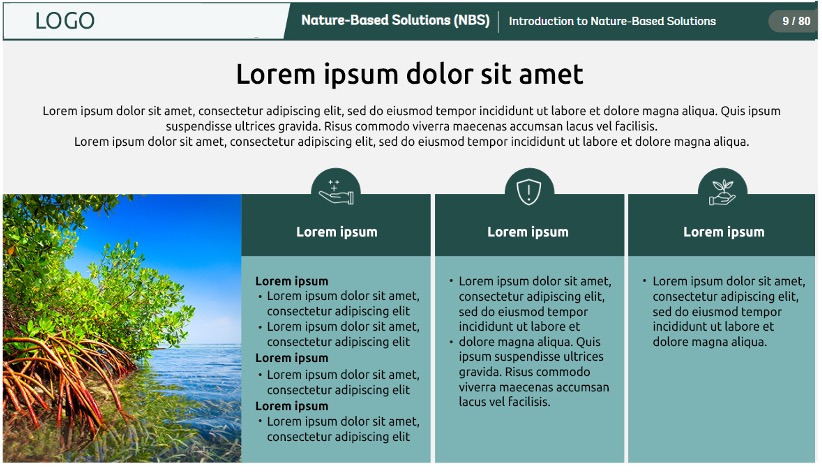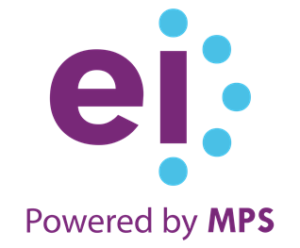Climate Competence Through Immersive Learning
A major international development organization equipped its global workforce and government partners with foundational knowledge of nature-based solutions (NBS), a key tool in addressing climate change.
The result: a scalable, immersive learning experience that built cross-sector climate literacy, supported pre-training alignment across global teams, and laid the groundwork for climate-resilient development.
Accessible through a centralized learning platform and structured around real-world case studies, this scenario-driven course helped learners connect policy, economics, and technical strategies through the shared lens of environmental resilience.
Introduction: Bridging The Climate Knowledge Gap Through Skill Development
The worsening state of the climate highlights the critical need for sustainable and effective approaches to development. For a leading global development institution, this translated into a pressing internal need: to empower its staff and government counterparts with the tools and insights needed to design and implement nature-based interventions.
Recognizing a gap in baseline knowledge across its global teams, the organization partnered with EI to create a 75-minute self-paced eLearning course that contextualized NBS through sectoral, governance, and economic lenses.
The course became a foundational pre-training tool, ensuring that learners stepped into in-person sessions with clarity, alignment, and a shared understanding of how nature-based solutions drive climate action.
Client Overview: International Development Institution With Global Reach
With a global footprint, the organization supports governments and communities through funding, technical assistance, and policy guidance, focusing on sustainable development and poverty reduction. Its climate investment arm recognized a key skills gap and prioritized upskilling economists, field practitioners, and policymakers on how nature-based solutions can be effectively applied across sectors such as agriculture, water, urban planning, and disaster resilience.
The Challenge: Gaps In Foundational Knowledge And Application Of Nature-Based Solutions
Despite their proven potential, nature-based solutions remained underutilized due to low awareness among stakeholders. Key challenges included:
- Inconsistent baseline knowledge across internal teams and government partners.
- Limited exposure to practical, real-world NBS examples.
- Unfamiliarity with economic and sector-specific applications.
- Fragmented understanding across global regions and disciplines.
This knowledge gap impacted collaboration, slowed project development, and limited the integration of NBS into climate-smart planning. A foundational, scenario-driven learning program was needed to unify understanding and enable informed decision making.
The Solution: Scenario-Based Learning To Bring Climate Concepts To Life
To meet this goal, EI developed a digital learning program grounded in adult learning principles, rich visuals, and relatable scenarios. The 75-minute course was built using Articulate Storyline and structured into five progressive modules.
Key Features Of The Learning Experience
Real-World Scenario
The course followed a fictional province navigating climate-related water issues. Learners explored how NBS, such as reforestation, wetland restoration, and natural infrastructure, could be used to mitigate risks and improve outcomes.
Conversational Design
Learning unfolded through realistic character interactions. Conversations between local leaders, technical experts, and economists brought nuance and emotional connection to the content.
Infographics And Authentic Imagery
Custom visuals and actual photographs of NBS projects were used to illustrate interventions across coasts, cities, farmlands, wetlands, and forests.
Case Study Wrap-Ups
Each section closed with a real-life case study showcasing results from global NBS initiatives, linking theory to practical implementation.
Interactive Checkpoints
Learners applied key concepts through scenario-based questions and received instant feedback to reinforce learning.
Rigorous Assessment
A final assessment required an 80% score to complete the course, ensuring knowledge retention and readiness for more advanced programs.


Results And Measurable Impact
Although formal metrics are still being collected, early outcomes indicate significant benefits:
- Baseline alignment. The course has aligned a diverse cohort of learners, including internal staff and external stakeholders, on NBS fundamentals.
- Scalable pre-training integration. It now serves as a mandatory precursor to all in-person training sessions on climate resilience and environmental policy.
- Positive learner feedback. Users appreciated the realistic scenarios, visual design, and sector-specific examples. Case studies were highlighted as particularly insightful.
Strategic Alignment And Future Outlook
The course supports the organization's broader objective of fostering resilient development and climate-smart policymaking. It reflects a shift from knowledge dissemination to competency building, preparing learners for real-world challenges in urban development, agriculture, water management, and more.
Conclusion: Building Capacity For A Liveable Planet
The foundational NBS course strengthened alignment across internal teams and external stakeholders, supported informed policy dialogue, and contributed to broader climate-resilient development goals.
Through scenario-based learning, real-world case studies, and structured Instructional Design, the program demonstrated how digital training can build foundational skills and support sustainable development outcomes at scale.
Read More:
- 7 Examples of Scenario-Based Learning (SBL) for Both Formal and Informal Learning
- Why Digital Learning Programs Hold the Key for Organizations to Bridge Workforce Skills Gap
Frequently Asked Questions
NBS use natural processes, like reforestation and wetland restoration, to tackle climate issues while supporting ecosystems and communities.
It targeted internal staff, government partners, and policymakers across sectors like water, agriculture, and urban planning.
The 75-minute course used real-world scenarios, conversational design, visuals, and case studies to engage learners and reinforce key concepts.
Yes, the immersive, scenario-driven approach can be adapted for topics like ESG, sustainable agriculture, or disaster resilience.
It has improved baseline knowledge, aligned teams globally, and become a required pre-training step for climate-related programs.










